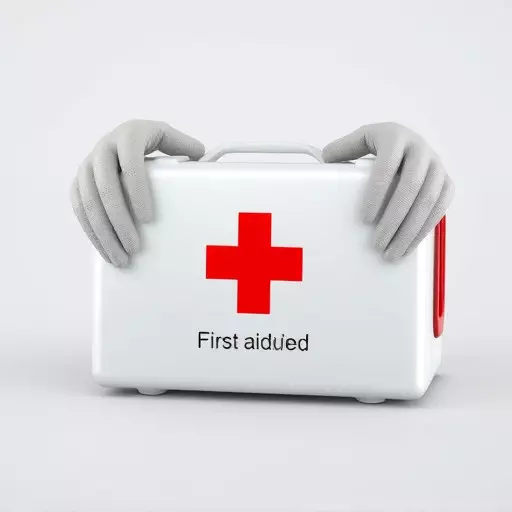Understanding fractures and sprains is crucial for anyone with first aid and CPR training. A fracture is a broken or cracked bone causing immediate pain, swelling, and deformity, while sprains involve stretched or torn ligaments leading to pain, bruising, and joint instability. Basic life support (BLS) training emphasizes prompt assessment, stabilization, and management of these injuries until professional help arrives. Swift action, proper knowledge, and adherence to first aid certification requirements are vital for effective treatment and prevention of further damage.
In the event of a fracture or sprain, prompt and effective first aid can make a significant difference in recovery. Understanding these common yet serious injuries, their causes, and recognizing key signs is essential. This guide covers everything from assessing the injury to advanced stabilization techniques, focusing on empowering individuals with basic life support training and first aid certification requirements. Learn about managing pain, red flags indicating emergency care, and preventive tips for daily safety, ensuring you’re prepared to handle these situations effectively.
- Understanding Fractures and Sprains: Types and Causes
- Assessing the Injury: Recognizing Signs and Symptoms
- Basic First Aid Steps for Fractures and Sprains
- Managing Pain and Stabilization Techniques
- When to Seek Medical Attention: Red Flags and Emergency Care
- First Aid and CPR Training: Benefits and Certification Requirements
- Preventing Injuries: Tips for Daily Safety and Injury Avoidance
Understanding Fractures and Sprains: Types and Causes
Fractures and sprains are common injuries that require immediate attention to prevent further damage and promote healing. Understanding these injuries is crucial for anyone with first aid and CPR training, as they often occur in various settings, from sporting events to everyday accidents.
A fracture is a break or crack in a bone, ranging from a simple hairline crack to complete severing. They can be caused by trauma, such as a fall or direct impact, leading to immediate pain, swelling, and deformity at the affected site. Sprains, on the other hand, involve the stretching or tearing of ligaments, often occurring when a joint is twisted or overstretched. Unlike fractures, sprains may not always cause visible deformities but are characterized by pain, bruising, and instability around the joint. Basic life support training and first aid certification requirements emphasize prompt assessment and stabilization to manage these injuries effectively until professional medical help arrives.
Assessing the Injury: Recognizing Signs and Symptoms
When assessing a fracture or sprain, it’s crucial to act swiftly while gathering essential information. First aid and CPR training can prove invaluable in such situations. The affected individual might exhibit signs like intense pain, swelling, deformity at the injured site, limited range of motion, and bruising. In the case of a suspected fracture, prompt attention is critical to prevent further damage. Basic life support (BLS) training equips individuals with the skills to assess vital signs, manage bleeding, and maintain airway integrity until professional medical help arrives.
Understanding these indicators and knowing the first aid certification requirements can make all the difference in managing fractures and sprains effectively. These injuries require immediate care, including immobilizing the affected area to prevent further injury and seeking medical attention promptly.
Basic First Aid Steps for Fractures and Sprains
In the event of a fracture or sprain, immediate and proper first aid can significantly reduce pain and prevent further damage. Basic life support training and CPR certification are valuable skills that empower individuals to respond effectively during emergencies. When dealing with suspected fractures or sprains, the first step is to ensure the safety of both the patient and yourself. This involves maintaining a calm demeanor and assessing the scene for potential hazards.
After ensuring safety, the next crucial step is to stabilize the affected area. For fractures, this might involve immobilizing the broken bone using a splint or sling. In cases of sprains, gentle compression and elevation can help reduce swelling. It’s important to remember that first aid certification requirements vary, but knowing basic first aid techniques, such as these, can make all the difference in providing essential support until professional medical assistance arrives.
Managing Pain and Stabilization Techniques
Managing pain and stabilizing an injured area are critical steps in first aid for fractures or sprains. While waiting for medical professionals, over-the-counter pain relievers like ibuprofen can help alleviate discomfort. Applying ice packs wrapped in a thin towel can also reduce swelling and numb the pain temporarily.
For stabilization, consider using splints or slings available in standard first aid kits. Splints should be firm enough to keep the broken bone immobile but not so tight as to cut off circulation. Slings are ideal for upper limb injuries, supporting both the injured area and the person’s body weight. Basic Life Support (BLS) training and CPR certification can equip individuals with essential skills to handle such emergencies until professional help arrives, ensuring prompt and effective treatment. Remember, first aid certification requirements vary, so it’s crucial to check local guidelines or consult a healthcare provider for specific training needs.
When to Seek Medical Attention: Red Flags and Emergency Care
Knowing when to seek medical attention for fractures and sprains is crucial. While minor injuries can often be treated at home with basic first aid, certain signs and symptoms indicate a more serious condition that requires prompt professional care. Red flags such as severe pain, deformity in the affected area, palpable tenderness, or inability to walk or move the limb without intense pain should never be ignored. These could suggest a compound fracture or severe sprain, which necessitate emergency medical intervention.
In cases of open fractures, where there is visible breaking of the skin over the bone, immediate first aid and CPR training becomes critical. Additionally, if the patient experiences numbness, tingling, or loss of color in the affected limb, it could indicate a severe nerve or blood vessel injury. Basic life support training equips individuals with the skills to recognize these emergencies and provide vital care until professional medical help arrives. For all serious injuries, especially those that hinder mobility, it is essential to obtain first aid certification to ensure proper handling of such situations and meet the required standards for emergency care.
First Aid and CPR Training: Benefits and Certification Requirements
First aid and CPR (Cardiopulmonary Resuscitation) training are invaluable skills that can make a significant difference in emergency situations, especially when dealing with fractures and sprains. These life-saving techniques provide individuals with the knowledge and confidence to respond effectively until professional medical help arrives. By learning basic life support training, you gain practical skills to manage critical conditions like cardiac arrest or choking, ensuring better outcomes for injured people.
Obtaining a first aid certification is a requirement for many high-risk professions and can also be beneficial for personal safety. Various organizations offer comprehensive courses that cover not just CPR but also treating fractures, managing bleeding, and handling other common injuries. These programs typically include practical demonstrations and hands-on practice sessions to ensure individuals are prepared to act in real-world scenarios. Certification requirements may vary by region, so it’s essential to choose a reputable training provider that aligns with local standards.
Preventing Injuries: Tips for Daily Safety and Injury Avoidance
Preventing Injuries: Tips for Daily Safety and Injury Avoidance
Incorporating basic first aid and CPR training into your routine is a crucial step in preparing for unexpected emergencies. This knowledge enables individuals to respond effectively when someone suffers a fracture or sprain, potentially reducing severe consequences. Regular practice of basic life support training ensures you’re ready to provide immediate assistance until professional help arrives. Many community centers and healthcare providers offer first aid certification courses that cater to diverse skill levels, making it accessible for everyone to learn these vital skills.
To minimize the risk of fractures and sprains, adopt preventive measures in your daily life. This includes wearing appropriate protective gear during physical activities, maintaining a safe living environment free from tripping hazards, and adopting healthy habits like regular exercise to strengthen muscles and improve balance. Being proactive about safety not only enhances personal well-being but also contributes to a community’s overall resilience against injuries.


